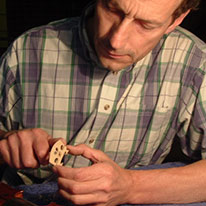Positioning the Bridge
Make sure at all times that the tailpiece side of the bridge is kept at a 90 degree angle with the instrument’s edges when viewed sideways. Simply check this by placing an envelope on the edge of the instrument. The bridge, at the fingerboard side, should lean back towards the tailpiece because of its taper. The inner nicks of both f-holes are to be in line with half the feet thickness and the outer strings equally spaced from the fingerboard edges. The bridge may not stand in its correct position if the neck is not straight. A number of compromises may then have to be made.
Bridges are always pulled towards the fingerboard, but will be pulled more towards the fingerboard if gut strings are used, as they stretch more and break earlier than steel or synthetic core strings. The bridge will bend as a result. Bridges not only bend but also have the tendency to twist, as the lower strings pull the bridge more towards the fingerboard than the higher strings. Bent and/or twisted bridges alter the speaking length of the strings which results in poor harmonics and intervals across the strings. Badly bent bridges may fall over or break. This should be avoided from happening at all cost as a falling or breaking bridge makes a lot of noise and the tailpiece can do much damage to the varnish or make a dent or crack in the wood.
 If a bridge needs to be set straight, place the instrument on a towel on a table with the tailpiece towards you and the scroll away from you. Place a piece of cardboard under the tailpiece to protect your instrument, just in case the bridge falls over. Hold the bridge with both hands between the index fingers and thumbs. Move the bridge with firm pressure only 1 millimetre at a time ensuring not to go too far. If metal strings are used, it may be necessary to reduce the string tension a little. Check frequently with the square edge of an envelope until the bridge stands at a 90 degree angle with the instrument’s edge. If the bridge is bent or the feet do not fit absolutely perfectly to the top after having placed the bridge on the correct place and angle, have the bridge refitted or replaced, as an incorrectly fitting bridge dents and damages the surface of the instrument and transmits the vibrations poorly to the top, resulting in poor sound. Never turn the bridge around as it will not fit but will damage the surface. Do not constantly fuss and tamper with different bridges, soundposts etc. but let the instrument settle. Soundpost and bridge adjustments are done only with a distinct change of season or climate. Please inform me if you prefer a more rounded bridge or have other special requirements or preferences.
If a bridge needs to be set straight, place the instrument on a towel on a table with the tailpiece towards you and the scroll away from you. Place a piece of cardboard under the tailpiece to protect your instrument, just in case the bridge falls over. Hold the bridge with both hands between the index fingers and thumbs. Move the bridge with firm pressure only 1 millimetre at a time ensuring not to go too far. If metal strings are used, it may be necessary to reduce the string tension a little. Check frequently with the square edge of an envelope until the bridge stands at a 90 degree angle with the instrument’s edge. If the bridge is bent or the feet do not fit absolutely perfectly to the top after having placed the bridge on the correct place and angle, have the bridge refitted or replaced, as an incorrectly fitting bridge dents and damages the surface of the instrument and transmits the vibrations poorly to the top, resulting in poor sound. Never turn the bridge around as it will not fit but will damage the surface. Do not constantly fuss and tamper with different bridges, soundposts etc. but let the instrument settle. Soundpost and bridge adjustments are done only with a distinct change of season or climate. Please inform me if you prefer a more rounded bridge or have other special requirements or preferences.

